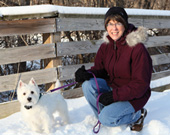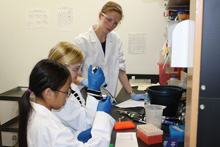Education Corner
Project CRYSTAL: Crystallographers Researching with Young Scientists, Teaching and Learning by Hazel M. Holden, Ph.D. and Dan Toomey
 Hazel M. Holden is a Professor of Biochemistry at the University of Wisconsin, Madison. Her present research interest focuses on the structure and function of enzymes involved in the biosynthesis of unusual deoxysugars. In her spare time she enjoys cycling and playing organ and piano. She is married to Professor Ivan Rayment, and they have two children, Kelsey and Harrison.
Hazel M. Holden is a Professor of Biochemistry at the University of Wisconsin, Madison. Her present research interest focuses on the structure and function of enzymes involved in the biosynthesis of unusual deoxysugars. In her spare time she enjoys cycling and playing organ and piano. She is married to Professor Ivan Rayment, and they have two children, Kelsey and Harrison.  Dan Toomey has taught science for 7 years at Edgewood Campus School in Madison, Wisconsin. He is a Science Olympiad coach, a SMART team coach, Adjunct faculty member at Edgewood College's School of Education, and an NSF RET participant. In his spare time he enjoys spending time with his family, especially outdoors.
Dan Toomey has taught science for 7 years at Edgewood Campus School in Madison, Wisconsin. He is a Science Olympiad coach, a SMART team coach, Adjunct faculty member at Edgewood College's School of Education, and an NSF RET participant. In his spare time he enjoys spending time with his family, especially outdoors.The concept of Project CRYSTAL (Crystallographers Researching with Young Scientists, Teaching and Learning) began by chance one spring day in March of 2007 in Madison, Wisconsin. My daughter, Kelsey Rayment, was complaining to her friends in school about having a mother as a scientist. She was overheard by her science teacher, Mr. Dan Toomey, who immediately asked her if I would come in and present my work to his class. When Dan called me and asked specifically what my research was about, I hesitated because I never expected a seventh grade teacher to even know about X-ray crystallography. To my surprise, Dan responded immediately because the previous year he had been involved with the SMART Teams, which is based at the Milwaukee School of Engineering (cbm.msoe.edu). SMART stands for "Students Modeling A Research Topic," and the students involved with this program are matched to a mentor who then teaches them about the 3D structure of their favorite protein.

Shown on the cover of
Biochemistry are crystals of a
novel C-3'-methyltransferase
involved in the production of
D-tetronitrose, an unusual
sugar found attached to the
antitumor agent tetrocarcin
A or the antibiotic kijanimicin.
The crystals were grown by
Project CRYSTAL's Manpreet
Kaur and Marie K. Avey.1

Manpreet and Marie at a
poster session presenting
their structure.

Crystals of AntD

Rachel Kubiak watching the
new students set up cloning
experiments.

Becky Phillips with Melissa,
Sarah, Malaika, and Gwen
The first lecture to Dan's class was an eye-opening experience. I spoke to the students about X-ray crystallography and protein structure. To put things in the proper context, it is important to point out that these students did not even know what a covalent bond was, let alone a protein. I had to start my lecture off with a discussion of the periodic table and had to explain a bit about molecular bonding. What was fascinating, however, was to watch these students sit up in their seats when I explained how carbon monoxide binds to hemoglobin. Afterwards, they wrote me a thank-you note, and one of them remarked "Thank you, I learned how carbon monoxide kills you."
In the spring of 2008, Dan and I submitted a grant to the NSF to establish Project CRYSTAL. The proposal included both basic research on enzymes involved in unusual deoxysugar biosynthesis and biochemistry outreach to middle school students. Why did Dan and I choose to set up Project CRYSTAL specifically for these students rather than high school students? Because these young people are undergoing enormous changes both emotionally and physically, and by the time they reach high school it is almost too late to instill a joy for chemistry, biochemistry, and physics. Chemistry needs to be presented, with some rigor, at an earlier age than ninth grade.
The most important and fundamental question all of us can ask is how can we make chemistry exciting to these students and compete against their fascination with iPods, cell phones, and other high-tech gadgets. First and foremost, the chemistry has to be relevant to their everyday lives. When my husband, Ivan Rayment, and I were growing up we had chemistry sets, and we learned in our chemistry classes how to blow things up. But today, teaching students how to blow things up would not be well received. So how do we make chemistry exciting? We teach it in the context of biology, and in particular nutrition. This is an especially timely topic given the rising incidence of obesity among young people in the United States.
In 2009, Dan and I were awarded an NSF grant, and Project CRYSTAL "crystallized." The two founding graduate student mentors were Rachel Kubiak and Nate Bruender. Currently, Project CRYSTAL has two major missions: (1) to instill a love for chemistry in middle school students by studying the inner workings of nutrition, thereby leading to healthy life choices and (2) to provide a hands-on laboratory experience in an active, state-of-the-art research laboratory, thus fostering interest in a scientific career. To achieve the first mission, Dan, the graduate students, and I are developing teaching modules based upon the chemistry of sugars, fats, and proteins. These modules include the concepts of matter, electrons, neutrons, protons, atoms, molecules, and chemical bonding. We are hoping to eventually write a biochemistry textbook for middle school students.
To achieve the second goal, four middle school students have been coming to my laboratory once a week during the school year to participate in academic research. These students are learning fundamental techniques such as molecular cloning, protein purification, crystallization, X-ray data collection, and protein model building. Last year two of the students, Manpreet Kaur and Marie K. Avey, were
co-authors on a paper published in Biochemistry,1 and their crystals were featured on its cover. These students also crystallized the enzyme AntD; a paper describing the structural analysis of this protein was recently published.2
This year's group consists of Sarah, Melissa, Gwen, and Malaika, and they are being mentored by graduate students Rachel Kubiak and Becky Phillips. It has been a very exciting year so far, and these middle school students are getting close to having their first proteins over-expressed and purified. Crystallization trials will begin shortly if all goes well!
It has been an absolute privilege working with these middle school students, and all of us are grateful to the NSF for supporting this endeavor. More details concerning Project CRYSTAL can be found at www.projectcrystal.org.
- N.A. Bruender, J.B. Thoden, M. Kaur, M.K. Avey, H.M. Holden (2010) Molecular architecture of a C-3'-methyltransferase involved in the biosynthesis of D-tetronitrose. Biochemistry 49:5891-5898. doi: 10.1021/bi100782b
- R.L. Kubiak, H.M. Holden (2012) Structural studies of AntD: an N-Acyltransferase involved in the biosynthesis of D-anthrose. Biochemistry 51:867-878. doi: 10.1021/bi201650c
